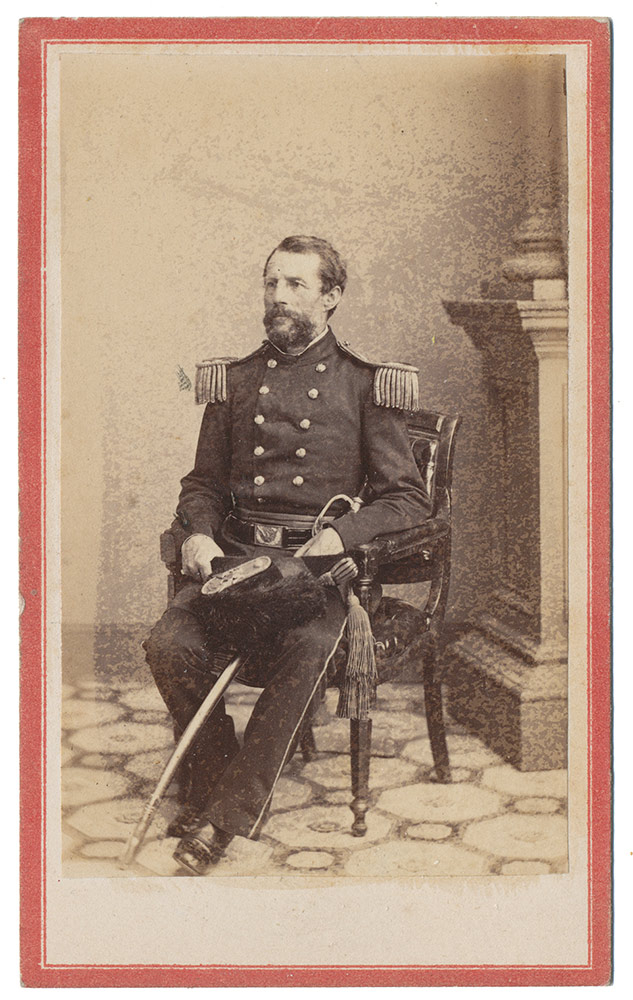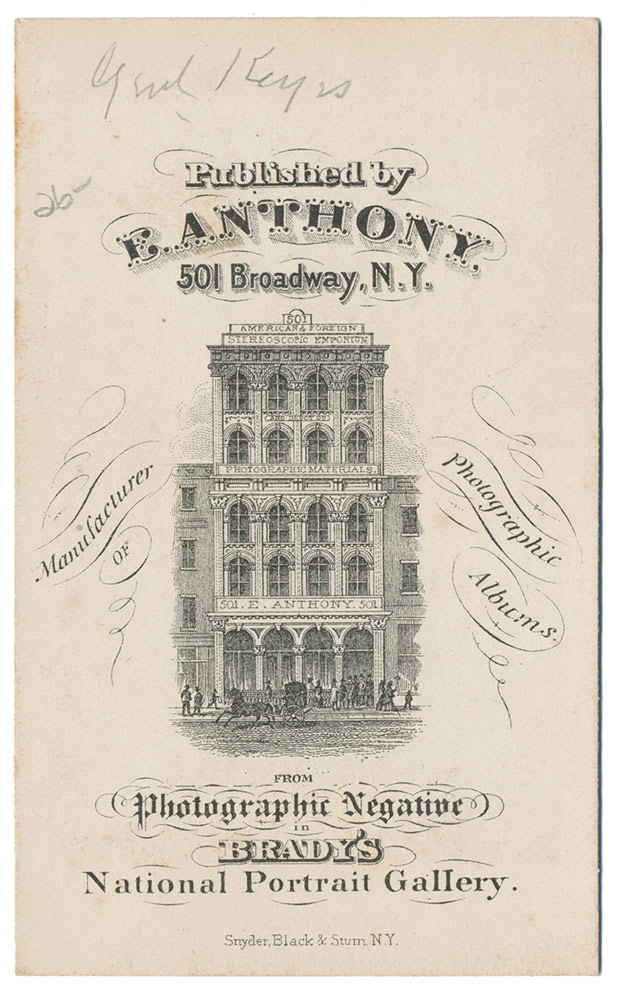site search
online catalog
FULL SEATED CDV OF GENERAL ERASMUS D. KEYES

Hover to zoom


$80.00 SOLD
Originally $100.00
Quantity Available: None
Item Code: 259-50
Image shows Keyes seated in a chair holding his sword and bicorn in his lap. He wears a dark double-breasted frock coat with brush epaulettes and matching dark trousers with a thin light leg stripe. At his waist is his sash and waist belt with rectangular NCO belt plate with applied silver wreath. The sword he has looks to be a Model 1850 Field and Staff officer’s sword. His bicorn with plume covers most of the hilt.
Image is clear with good contrast. There appears to be some shadowing around the General but this does not detract.
Mount is clean with a red border.
Reverse has E. ANTHONY back mark with a large building and states the image is from a BRADY negative. Pencil inscription on top of reverse reads “GENL. KEYES.”
Erasmus Darwin Keyes was born May 29, 1810 in Brimfield, Massachusetts. While still a boy, he moved with his family to Kennebec County, Maine. Erasmus entered the United States Military Academy and graduated 10th out of a class of 45 in 1832. He was commissioned a second lieutenant in the 3rd U.S. Artillery.
Keyes served in Charleston Harbor during the nullification crisis of 1832–33, as an aide to General Winfield Scott from 1837 to 1841 and was promoted to captain on November 30, 1841. He served in various garrisons until 1844 and then as an artillery and cavalry instructor at West Point.
He was then sent to California with the 3rd U.S. Artillery in 1854 and served on the Pacific frontier until 1860. Keyes received his commission of major on October 12, 1858. General Scott appointed Keyes his military secretary on January 1, 1860, a position he filled until April 1861.
At the outbreak of the Civil War, Keyes was promoted to colonel of the 11th U.S. Infantry on May 14, 1861. He then served briefly on the staff of New York Governor Edwin D. Morgan until June 25, 1861.
At the First Battle of Bull Run, Keyes commanded the 1st Brigade, 1st Division. In August 1861 he was promoted to the rank of brigadier general of volunteers with date of rank of May 17, 1861, the third-ranking brigadier general in the Army.
Keyes command of a division from November 9, 1861, to March 13, 1862 before being given command of IV Corps. He led this Corps from its inception on March 3, 1862, until its discontinuation on August 1, 1863.
During Maj. Gen. George B. McClellan's Peninsula Campaign, Keyes saw action at Lee's Mill, Yorktown, Bottom's Bridge, Savage's Station, Seven Pines, Charles City Cross Roads, Malvern Hill, and Harrison's Landing. For gallantry at Fair Oaks, Keyes received a brevet of brigadier general in the regular army.
After the Army of the Potomac left the Peninsula, the IV Corps remained behind as a part of Maj. Gen. John A. Dix's Department of Virginia. On March 12, 1863, President Lincoln nominated Keyes for promotion to the grade of major general, U.S. Volunteers, to rank from May 5, 1862 and the U.S. Senate confirmed the award on March 13, 1862. In addition to the IV Corps, he commanded the Yorktown District, VII Corps, and the division at Suffolk. Among Keyes's other actions were a raid to White House, Virginia, on January 7, 1863, and an expedition to West Point, Virginia, on May 7, 1863.
During the Gettysburg Campaign, Keyes fell afoul of General Dix's strategic plan to demonstrate heavily against Richmond in order to divert Confederate reinforcements from General Robert E. Lee's army in Pennsylvania. Keyes retreated from his position in the face of what Dix deemed to be inferior forces, so Dix had Keyes removed from command.
Although Keyes asked for an investigation of the charges that led to his removal, the request was never granted. He then served on various boards and commissions, including the board for retiring disabled officers from July 15, 1863, until his resignation and retirement from the army on May 6, 1864.
Following the war, Keyes moved to San Francisco, where he became financially successful. He was president of a Mexican gold mining company in 1867–1869, and vice president of the California vine-culture society from 1868 to 1872. He also was engaged in the savings and loan business.
He became a member of the California Commandery of the Military Order of the Loyal Legion of the United States and was the author of “The Rear Guard at Malvern Hill” as part of The Century Company's “Battles and Leaders of the Civil War” series, as well as “Fifty Years' Observation of Men and Events” (New York, 1884). This was later reprinted as “Fighting Indians in Washington Territory” (Fairfax, Washington, 1988). His work “From West Point to California” was published posthumously in 1950.
While on a trip to Europe with his wife, Keyes died in Nice, France, at age 85. He is buried in West Point Cemetery. [ad] [ph:L]
~~~~~~~~~~~~~~~~~~~~~~~~~~~~~~~~~~~
THIS ITEM, AS WITH ALL OTHER ITEMS AVAILABLE ON OUR WEB SITE,
MAY BE PURCHASED THROUGH OUR LAYAWAY PROGRAM.
CLICK HERE FOR OUR POLICIES AND TERMS.
THANK YOU!
Inquire About FULL SEATED CDV OF GENERAL ERASMUS D. KEYES
Most Popular
Historical Firearms Stolen From The National Civil War Museum In Harrisburg, Pa »
Theft From Gravesite Of Gen. John Reynolds »
Selection Of Unframed Prints By Don Troiani »
Fine Condition Brass Infantry Bugle Insignia »
Large English Bowie Knife With Sheath 1870’S – 1880’S »
Imported (Clauberg) Us Model 1860 Light Cavalry Officer's Saber »
featured item
FROM LIFE CDV VIEW OF CUSTER BY GOLDIN
This is a very nice “from-life” view of Custer by John Goldin & Co. in May 1865, Katz #70 in his Custer in Photographs, taken in May 1865. Custer is shown seated, from mid-calf up, resting one arm on the back of the photographer’s chair,… (2024-450). Learn More »


